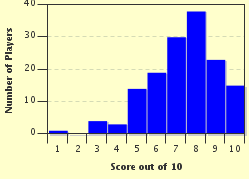Quiz Answer Key and Fun Facts
1. Victor Hugo's "The Hunchback of Notre-Dame" takes place in 1482, which was also the year that Diogo Cão became the first European to explore which of the following rivers?
2. "The Three Musketeers", written by Alexandre Dumas, begins in a year that saw a new monarch crowned the ruler of England. What year and monarch was it?
3. Jonathan Swift's "Gulliver's Travels" starts in the same year that a treaty was signed to end the Austro-Ottoman War, which is considered the beginning of the end of the Ottoman Empire. What was the year and the treaty?
4. "The Last of the Mohicans: A Narrative of 1757" by James Fenimore Cooper takes place during the French and Indian War. Which French leader did Robert-François Damiens unsuccessfully try to assassinate in 1757?
5. The events leading up to and during the French Revolution are the setting for Charles Dickens' "A Tale of Two Cities", including the Storming of the Bastille. When did this French prison fall?
6. In Jules Verne's sci-fi adventure "20,000 Leagues Under the Sea", the ship "Abraham Lincoln" sails from New York to hunt down a sea creature that turns out to be a submarine. The voyage takes place in the same year that another, future science fiction author was born. Who is this timely author, and what was the year?
7. Sir Arthur Conan Doyle's fictional "consulting detective" Sherlock Holmes started renting rooms in London from Mrs. Hudson during the end of the Victorian era. Which United States president died in office the same year that Holmes moved in to 221B Baker Street?
8. "The Great Gatsby", by F. Scott Fitzgerald, takes place in the Jazz Age, during the same year that Howard Carter made this great archaeological discovery in the Valley of the Kings. What did he find, and when?
9. George Orwell's dystopian world of Big Brother and thoughtcrime in "Nineteen Eighty-four" may not have actually happened, but 1984 did see the Soviet Union and other countries boycott this sporting event. Which event did they boycott?
10. Arthur C. Clarke thought it would be the year of "A Space Odyssey", when the HAL-9000 artificial intelligence goes rogue on a mission to one of Saturn's moons. Instead, it was the year the September 11 attacks destroyed the World Trade Center towers. When was it?
Source: Author
jcpetersen
This quiz was reviewed by FunTrivia editor
bloomsby before going online.
Any errors found in FunTrivia content are routinely corrected through our feedback system.


